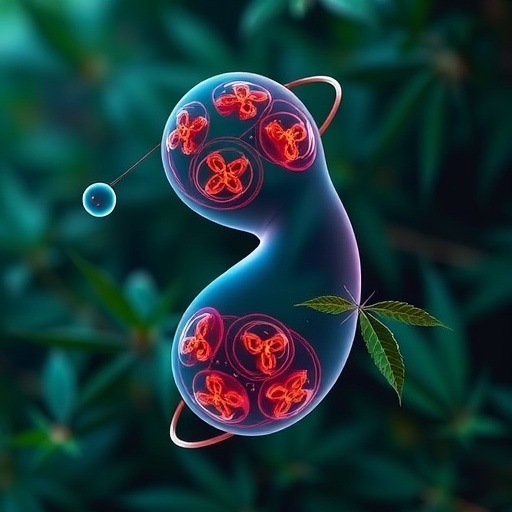In recent years, cannabidiol (CBD) has surged in popularity as a compound believed to possess therapeutic benefits without the psychoactive effects associated with tetrahydrocannabinol (THC). Pregnant individuals, in particular, have increasingly turned to CBD as a natural remedy for a range of symptoms, from nausea to anxiety, under the assumption of its safety. However, groundbreaking new research published in Translational Psychiatry challenges this presumption by exploring the nuanced impacts of prenatal cannabidiol exposure on offspring anxiety-related behaviors, revealing striking sex-specific developmental disruptions.
The study, conducted by Iezzi, Cáceres-Rodríguez, Chavis, and colleagues, delves deep into how CBD administration during pregnancy alters the developmental trajectory of anxiety-like behaviors in male and female offspring differently. This work is significant as it sheds light on a largely unexplored area—the neurodevelopmental consequences of maternal CBD intake during gestation—and highlights the critical role of sex as a biological variable in neuropsychiatric outcomes.
Through meticulous behavioral assays conducted over various stages of development, the researchers demonstrated that male and female offspring prenatally exposed to CBD exhibited marked divergences in anxiety-like behaviors. These behaviors are typically assessed through experimental paradigms such as open field tests, elevated plus mazes, and social interaction assays, which are widely accepted in the field to gauge anxiety levels in rodent models. The findings reveal that prenatal CBD exposure disrupts the normative developmental progression of these behaviors, but the patterns of disruption are distinctly sex-specific.
In males, prenatal cannabidiol exposure appeared to blunt anxiety-like responses during key developmental windows, suggesting a potential dampening effect on behavioral inhibition or threat sensitivity mechanisms. Female offspring, by contrast, exhibited an exacerbated anxiety-like phenotype, indicating increased behavioral avoidance and heightened stress responsiveness. These observations underscore the complex interaction between cannabinoid signaling pathways and sex hormones during critical periods of neurodevelopment.
Mechanistically, the study proposes that prenatal CBD exposure may interfere with the endocannabinoid system (ECS), a ubiquitous neuromodulatory network essential for brain development, synaptic plasticity, and emotional regulation. The ECS is intricately involved in fetal brain maturation, impacting neuronal proliferation, migration, and circuitry formation. CBD’s modulation of ECS components, including CB1 and CB2 receptors, as well as its influence on key enzymes like FAAH which regulate endocannabinoid levels, could alter developmental processes in a sex-dependent manner owing to differential receptor expression and hormonal milieu.
Furthermore, the researchers examined the possible involvement of neuroendocrine factors, particularly the hypothalamic-pituitary-adrenal (HPA) axis, which governs stress responses and is known to exhibit sexual dimorphism. Prenatal CBD exposure may recalibrate HPA axis sensitivity, potentially altering corticosterone release patterns and feedback loops, thereby contributing to the observed behavioral phenotypes. This recalibration could lead to maladaptive stress regulation that manifests differentially across sexes.
The implications of these findings extend beyond basic neuroscience, raising important public health considerations. As CBD products become ubiquitous and are touted as safe for consumption during pregnancy, the risk of subtle yet enduring neurodevelopmental perturbations must be reevaluated. The study’s demonstration of sex-specific vulnerabilities highlights a potential blind spot in current regulatory approaches which often overlook nuanced developmental outcomes in favor of gross morphological assessments.
Behavioral disorders such as anxiety and depression frequently exhibit sex differences in prevalence, onset, and symptomatology. This research suggests that prenatal cannabinoid exposure could be an environmental factor contributing to these disparities. The fact that CBD—a compound marketed for its anxiolytic properties—may in fact prime the developing brain toward dysregulated anxiety phenotypes is both counterintuitive and profoundly consequential.
Notably, the investigation’s longitudinal design allowed for observed behavioral trajectories rather than cross-sectional snapshots, offering a richer understanding of how early-life exposure effects emerge and evolve across developmental stages. This approach is crucial for discerning transient versus persistent effects and for identifying critical windows during which intervention could mitigate risks.
The study also emphasizes the necessity for differentiated analyses based on sex in neurodevelopmental research. Historically, females have been underrepresented in preclinical studies, a gap this work helps to address by showcasing divergent outcomes and advocating for sex-informed clinical guidelines. The findings recommend cautious interpretation and application of CBD during pregnancy, urging clinicians and expectant individuals to weigh potential neurodevelopmental trade-offs.
Importantly, Iezzi and colleagues do not categorically dismiss the therapeutic potential of CBD but champion a more nuanced understanding of its interaction with the developing brain. They call for rigorous clinical studies to track neurodevelopmental and behavioral outcomes in children prenatally exposed to cannabinoids, advocating for stringent safety evaluations akin to those for pharmaceuticals prescribed during pregnancy.
At the molecular level, future research probing the epigenetic modifications induced by prenatal CBD could elucidate the persistent changes in gene expression that underlie altered anxiety phenotypes. Such investigations could reveal targets for pharmacological or behavioral interventions designed to restore normative developmental trajectories.
This work also invites reconsideration of the broader societal perception of cannabinoid use during pregnancy. As cannabis legalization and CBD product availability expand worldwide, public health messaging must incorporate emerging scientific insights about potential developmental risks, thereby enabling informed decision-making among prospective parents.
In conclusion, the study by Iezzi, Cáceres-Rodríguez, Chavis et al. represents a pivotal advance in understanding how prenatal cannabidiol exposure subtly yet significantly reshapes anxiety-related behaviors along sex-specific lines. By illuminating the complex biological interplay between cannabinoids, neurodevelopment, and sex hormone signaling, this research paves the way for a new era of cannabinoid safety science—one that balances therapeutic promise against developmental caution.
As the conversation around CBD’s place in modern medicine evolves, this work serves as both a warning and a guide. It implores us to explore cannabinoid biology with scientific rigor and sensitivity to developmental context, ensuring that the next generation is safeguarded from unforeseen neuropsychiatric consequences while harnessing the potential benefits that these compounds may offer.
Subject of Research:
Sex-specific disruptions in anxiety-like behavioral development due to prenatal cannabidiol exposure.
Article Title:
Sex-specific disruptions in the developmental trajectory of anxiety-like behaviors due to prenatal cannabidiol exposure.
Article References:
Iezzi, D., Cáceres-Rodríguez, A., Chavis, P. et al. Sex-specific disruptions in the developmental trajectory of anxiety-like behaviors due to prenatal cannabidiol exposure. Transl Psychiatry 15, 354 (2025). https://doi.org/10.1038/s41398-025-03517-x




